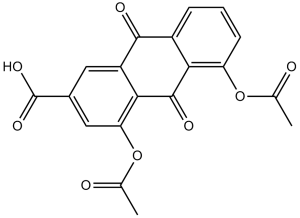
| 规格 | 价格 | 库存 | 数量 |
|---|---|---|---|
| 25mg |
|
||
| 50mg |
|
||
| 100mg |
|
||
| 250mg |
|
||
| 500mg |
|
||
| 1g |
|
||
| Other Sizes |
|
| 体外研究 (In Vitro) |
体外活性:双醋瑞因显着抑制 LPS 诱导的滑膜组织和软骨产生 IL-1β。双醋瑞因 (1 μM) 对软骨合成的抑制作用明显低于仅含有 LPS 的培养基。双醋瑞因 (1 μM) 减少滑膜组织和软骨培养基中的 NO 释放,并增加软骨培养基中的 IL-1ra 水平。双醋瑞因 (10 μM) 增强培养的牛关节软骨细胞中 TGF-β1 和 TGF-β2 的表达。双醋瑞因以剂量依赖性方式减少骨关节炎软骨下骨中白细胞介素 1 β (IL-1β) 诱导的 MMP-13 产生。双醋瑞因显着降低破骨细胞中 MMP-13 和组织蛋白酶 K 的活性。双醋瑞因有效阻断 IL-1β 对破骨细胞分化过程和成熟破骨细胞存活的影响。
|
||
|---|---|---|---|
| 体内研究 (In Vivo) |
双醋瑞因(100 mg/kg/天)显着抑制佐剂诱导的关节炎大鼠的足爪水肿和血清粘蛋白增加。在佐剂诱导的关节炎大鼠中,双醋瑞因(30 mg/kg/天)与萘普生(3 mg/kg/天)联合使用比单独使用萘普生具有显着更强的抗炎活性。双醋瑞因(100 mg/kg/天)还可以显着防止卵巢切除大鼠的骨质流失,降低血清碱性磷酸酶,并减少尿羟脯氨酸的排泄。双醋瑞因 (25 mg/kg) 可降低美利奴羊胫骨外侧平台病变(中间)区域的软骨和软骨下骨的厚度。
|
||
| 动物实验 |
|
||
| 药代性质 (ADME/PK) |
Absorption, Distribution and Excretion
Bioavailability of 50-60%. Entirely converted to the active metabolite rhein [DB13174] before reaching systemic circulation. 37% excreted in urine and 53% in feces as estimated in rats. 15-60L. Total CL is 1.5L/h and renal CL is 0.1L/h. Metabolism / Metabolites Entirely converted to rhien [DB13174] through double deacetylation before reaching systemic circulation. Rhein [DB13174] is further metabolized to rhein glucuronide and rhein sulfate. Biological Half-Life 4-10h. |
||
| 毒性/毒理 (Toxicokinetics/TK) |
Protein Binding
99% of rhein is bound to plasma proteins. |
||
| 参考文献 |
Osteoarthritis Cartilage.1999 May;7(3):272-80;Osteoarthritis Cartilage.1999 May;7(3):255-64.
|
||
| 其他信息 |
4,5-diacetyloxy-9,10-dioxo-2-anthracenecarboxylic acid is an anthraquinone.
Diacerein is a prodrug which is metabolized to rhein. It is currently approved in France for the treatment of osteoarthritis although the use of diacerein is restricted due to the side effects including severe diarrhea. Diacerein is under investigation for the treatment of Insulin Resistance, Diabetes Mellitus (Type 2), and Diabetes-Related Complications. Drug Indication For the treatment of osteoarthritis affecting the hip or knee. Mechanism of Action Diacerein's active metabolite rhein [DB13174] reduces cartilage destruction by decreasing expression of matrix metalloproteinase (MMP)-1 and -3 as well as upregulating tissue inhibitor of matrix metalloproteinases which serve to reduce the activity of several MMPs. The anti-inflammatory action of rhein reduces the level of interleukin-1beta activity which plays a large role in reduction of extracellular matrix production, MMP activity, and continued inflammation. Rhein reduces abnormal osteoblast synthetic activity through an unknown mechanism. Pharmacodynamics Decreases inflammation and cartilage destruction and also corrects altered osteoblast acitivity. |
| 分子式 |
C19H12O8
|
|
|---|---|---|
| 分子量 |
368.29
|
|
| 精确质量 |
368.053
|
|
| CAS号 |
13739-02-1
|
|
| 相关CAS号 |
Diacerein-d6;1325559-27-0
|
|
| PubChem CID |
26248
|
|
| 外观&性状 |
Light yellow to yellow solid powder
|
|
| 密度 |
1.5±0.1 g/cm3
|
|
| 沸点 |
631.5±55.0 °C at 760 mmHg
|
|
| 熔点 |
217-2180C
|
|
| 闪点 |
231.8±25.0 °C
|
|
| 蒸汽压 |
0.0±1.9 mmHg at 25°C
|
|
| 折射率 |
1.634
|
|
| LogP |
1.99
|
|
| tPSA |
124.04
|
|
| 氢键供体(HBD)数目 |
1
|
|
| 氢键受体(HBA)数目 |
8
|
|
| 可旋转键数目(RBC) |
5
|
|
| 重原子数目 |
27
|
|
| 分子复杂度/Complexity |
683
|
|
| 定义原子立体中心数目 |
0
|
|
| InChi Key |
TYNLGDBUJLVSMA-UHFFFAOYSA-N
|
|
| InChi Code |
InChI=1S/C19H12O8/c1-8(20)26-13-5-3-4-11-15(13)18(23)16-12(17(11)22)6-10(19(24)25)7-14(16)27-9(2)21/h3-7H,1-2H3,(H,24,25)
|
|
| 化学名 |
4,5-diacetyloxy-9,10-dioxoanthracene-2-carboxylic acid
|
|
| 别名 |
|
|
| HS Tariff Code |
2934.99.9001
|
|
| 存储方式 |
Powder -20°C 3 years 4°C 2 years In solvent -80°C 6 months -20°C 1 month |
|
| 运输条件 |
Room temperature (This product is stable at ambient temperature for a few days during ordinary shipping and time spent in Customs)
|
| 溶解度 (体外实验) |
|
|||
|---|---|---|---|---|
| 溶解度 (体内实验) |
配方 1 中的溶解度: 5 mg/mL (13.58 mM) in 1% (w/v) carboxymethylcellulose (CMC) (这些助溶剂从左到右依次添加,逐一添加), 悬浮液。
配方 2 中的溶解度: 1%CMC Na : 30mg/mL 请根据您的实验动物和给药方式选择适当的溶解配方/方案: 1、请先配制澄清的储备液(如:用DMSO配置50 或 100 mg/mL母液(储备液)); 2、取适量母液,按从左到右的顺序依次添加助溶剂,澄清后再加入下一助溶剂。以 下列配方为例说明 (注意此配方只用于说明,并不一定代表此产品 的实际溶解配方): 10% DMSO → 40% PEG300 → 5% Tween-80 → 45% ddH2O (或 saline); 假设最终工作液的体积为 1 mL, 浓度为5 mg/mL: 取 100 μL 50 mg/mL 的澄清 DMSO 储备液加到 400 μL PEG300 中,混合均匀/澄清;向上述体系中加入50 μL Tween-80,混合均匀/澄清;然后继续加入450 μL ddH2O (或 saline)定容至 1 mL; 3、溶剂前显示的百分比是指该溶剂在最终溶液/工作液中的体积所占比例; 4、 如产品在配制过程中出现沉淀/析出,可通过加热(≤50℃)或超声的方式助溶; 5、为保证最佳实验结果,工作液请现配现用! 6、如不确定怎么将母液配置成体内动物实验的工作液,请查看说明书或联系我们; 7、 以上所有助溶剂都可在 Invivochem.cn网站购买。 |
| 制备储备液 | 1 mg | 5 mg | 10 mg | |
| 1 mM | 2.7153 mL | 13.5763 mL | 27.1525 mL | |
| 5 mM | 0.5431 mL | 2.7153 mL | 5.4305 mL | |
| 10 mM | 0.2715 mL | 1.3576 mL | 2.7153 mL |
1、根据实验需要选择合适的溶剂配制储备液 (母液):对于大多数产品,InvivoChem推荐用DMSO配置母液 (比如:5、10、20mM或者10、20、50 mg/mL浓度),个别水溶性高的产品可直接溶于水。产品在DMSO 、水或其他溶剂中的具体溶解度详见上”溶解度 (体外)”部分;
2、如果您找不到您想要的溶解度信息,或者很难将产品溶解在溶液中,请联系我们;
3、建议使用下列计算器进行相关计算(摩尔浓度计算器、稀释计算器、分子量计算器、重组计算器等);
4、母液配好之后,将其分装到常规用量,并储存在-20°C或-80°C,尽量减少反复冻融循环。
计算结果:
工作液浓度: mg/mL;
DMSO母液配制方法: mg 药物溶于 μL DMSO溶液(母液浓度 mg/mL)。如该浓度超过该批次药物DMSO溶解度,请首先与我们联系。
体内配方配制方法:取 μL DMSO母液,加入 μL PEG300,混匀澄清后加入μL Tween 80,混匀澄清后加入 μL ddH2O,混匀澄清。
(1) 请确保溶液澄清之后,再加入下一种溶剂 (助溶剂) 。可利用涡旋、超声或水浴加热等方法助溶;
(2) 一定要按顺序加入溶剂 (助溶剂) 。